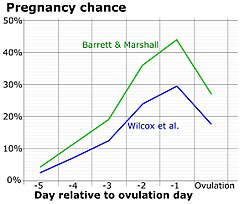排卵監測
外觀
此條目可參照英語維基百科相應條目來擴充。 |
| Fertility awareness | |
|---|---|
 | |
| 背景 | |
| 生育控制種類 | 行為 |
| 初次使用日期 | 1950年代(粘液) 1930年代中期(基礎體溫) 1930年(Knaus-Ogino) |
| 失效比率 (第一年) | |
| 完美使用 | 徵象體溫法:0.4%[2] Ovulation method: 3%[2] TwoDay method:4%[2] Standard Days method:5% |
| 一般使用 | 徵象體溫法:2% Ovulation Method: 11–34% TwoDay Method: 14% Standard Days Method:11–14% 日曆規律法:24% |
| 用法 | |
| 可逆性 | 可 |
| 注意事項 | 依使用者遵守嚴格程度和方法而不同 |
| 醫師診斷 | 無 |
| 優點及缺點 | |
| 是否可以防止性傳播疾病 | 無 |
| 週期 | Increased prediction |
| 好處 | 沒有副作用,此方法也可以用在助孕、個人的自我覺察、婚姻親密感較好 |
排卵監測[3](英語:Fertility awareness)是指一些用來判斷女性月經週期中可孕期(危險期)和不孕期的的方法[4]。這些方法可用於避孕、助孕或監測性健康和生殖健康[4]。若用排卵監測手段來避孕,每年依然會約有15%的女性會懷孕[4]。若完全精準的監測,懷孕率為1%至12%不等,若隨意監測,懷孕率為2%至34%不等,具體懷孕率取決於所使用的方法[5] 。排卵監測包括識別生育信號(基礎體溫、子宮頸粘液和宮頸位置)、記錄月經周期天數、或使用尿液測試條(即排卵預測試劑盒)[4][5]。在最多達10天的可孕期(危險期)內,應實行性禁慾或使用其他避孕方法[5]。有些排卵監測方法可以用應用程序或用生育能力測試儀器來協助[5] 。
排卵期測定沒有直接的副作用,不過無法通過排卵監測來預防性傳染病(STI)[4][6]。若是青少女月經不規律、睡眠不規律,排卵監測也能也會失效[5]。
截至2020年為止,全球約有3300萬女性使用此類避孕方法(占總避孕人數的3.5%)[7]。美國的比例也差不多,約為3.4%[4]。 自古以來就已經有一些關於生育及避孕的知識;不過一直到1920年至1970年期間,才有人提出用排卵監測手段來避孕[8]。這些措施實施的成本很低廉[6]。
相關條目
[編輯]參考
[編輯]- ^ Dunson, D.B.; Baird, D.D.; Wilcox, A.J.; Weinberg, C.R. Day-specific probabilities of clinical pregnancy based on two studies with imperfect measures of ovulation. Human Reproduction. 1999, 14 (7): 1835–1839. ISSN 1460-2350. PMID 10402400. doi:10.1093/humrep/14.7.1835
 .
.
- ^ 2.0 2.1 2.2 Trussell, James. Contraceptive efficacy. Hatcher, Robert A.; Trussell, James; Nelson, Anita L.; Cates, Willard Jr.; Kowal, Deborah; Policar, Michael S. (編). Contraceptive technology 20th revised. New York: Ardent Media. 2011: 779–863. ISBN 978-1-59708-004-0. ISSN 0091-9721. OCLC 781956734. Table 26–1 = Table 3–2 Percentage of women experiencing an unintended pregnancy during the first year of typical use and the first year of perfect use of contraception, and the percentage continuing use at the end of the first year. United States. 網際網路檔案館的存檔,存檔日期2017-02-15.
- ^ 军医提醒:女性如何监测排卵-新华网. 新華網_讓新聞離你更近. [2024-08-20] (中文).
- ^ 4.0 4.1 4.2 4.3 4.4 4.5 Cason, Patty; Cwiak, Carrie; Kowal, Deborah; Edelman, Alison. Contraceptive Technology 22. Jones & Bartlett Learning. 2023-09-26: 451–471 [2024-04-10]. ISBN 978-1-284-25503-4. (原始內容存檔於2024-04-10) (英語).
- ^ 5.0 5.1 5.2 5.3 5.4 Urrutia, Rachel Peragallo; Polis, Chelsea B. Fertility awareness based methods for pregnancy prevention. BMJ. 2019-07-11, 366: l4245 [2024-04-09]. ISSN 0959-8138. PMID 31296535. S2CID 195893695. doi:10.1136/bmj.l4245. (原始內容存檔於2024-03-26) (英語).
- ^ 6.0 6.1 Fertility Awareness Methods | Natural Birth Control. www.plannedparenthood.org. [2024-04-20]. (原始內容存檔於2024-04-17) (英語).
- ^ World Family Planning 2022 (PDF). United Nations. 2022 [2024-03-22]. ISBN 9789211483765. (原始內容 (PDF)存檔於2023-11-07).
- ^ Knight, Jane. The Complete Guide to Fertility Awareness. Routledge. 2016-11-03: PT32 [2024-04-20]. ISBN 978-1-317-65421-6. (原始內容存檔於2024-04-21) (英語).
| ||||||||||||||||||||||||||||||||||||
